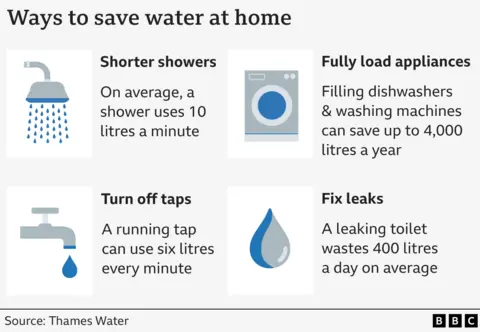Exceptionally low river levels raise fears over water supplies
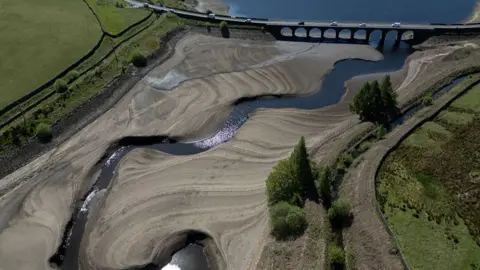 Getty Images
Getty ImagesMany of the UK's rivers have hit exceptionally low levels and that could worsen in the next three months, according to the Centre for Ecology & Hydrology (CEH), raising questions over supplies to households, farmers and businesses.
The warning comes after the driest spring in England since 1961, with northern regions experiencing the driest start to the year in nearly a century.
Almost all of the UK is expected to have below normal or low river levels in May, apart from the south-west of England and southern Wales.
The Environment Agency has said that the UK is at medium risk of drought and warned households of the risk of water restrictions.
The next 2-3 weeks will be "crucial" in determining if drought will happen, says Mark Owen, head of fisheries for the Angling Trust and a member of the National Drought Group.
That is the group led by the government that can declare if drought is officially underway.
The country is not now in drought, but the impacts of the exceptionally dry weather are already being felt.
Some farmers are being forced to water their crops instead of relying on rainfall, which is something that normally happens later in the year.
"We are having a drought now from an agricultural point of view," arable farmer Nick Deane told BBC News from his farm in Norfolk.
He had to start irrigating his fields in March.
"We have to ration our water and decide which areas we are going to put that water on in order to keep the crops growing," he said.
He warned that an extremely long drought would mean farmers struggle to produce food and more produce would need to be imported.
The dry and sunny weather this year has led to a larger area of the UK burned by wildfires this year compared to in any other entire year.
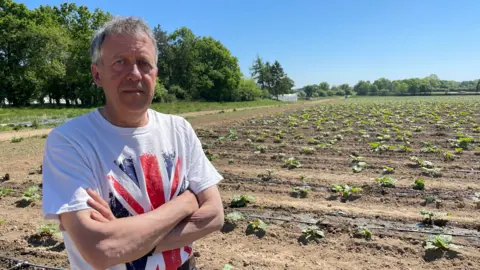 Malcolm Prior/BBC
Malcolm Prior/BBCThe last drought was in June-August 2022, which was the joint hottest summer (with 2018) and fifth driest since the 1890s.
Five companies introduced hosepipe bans, affecting 19 million people, and waterways had restricted navigation.
That drought was preceded by six months of very dry weather.
However, the wet summer in 2024 and moderately-wet winter means water supplies are in a better place now and water companies have larger reserves to rely on.
But dry weather earlier in the year has risks. It does "potentially pose a greater risk to water resources later on in the year, particularly if the dry weather continues," says Stephen Turner, hydrologist at the UK Centre for Ecology and Hydrology.
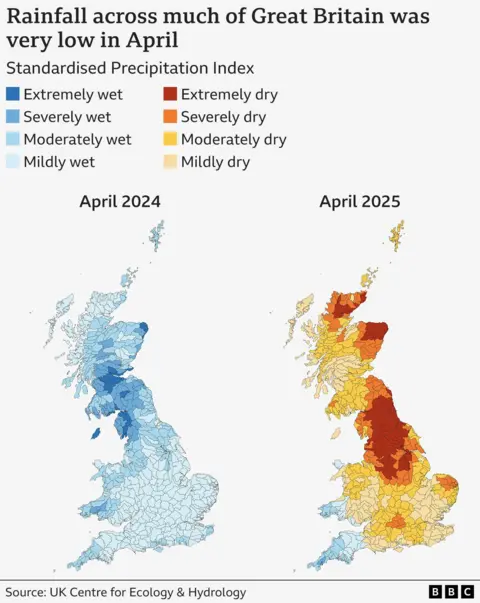
Last week, Richard Thompson, chair of the National Drought Group, warned that water companies may need to bring in water restrictions to protect supplies if the dry weather continues.
At the moment the key questions are when will it next rain and when it does, how much will there be.
There are some signs that some rain is on the horizon, with unsettled weather from the west at the end of next week.
Drinking water comes from different places depending on the geography and geology of regions.
Roughly speaking, the south of England takes a long time to get into drought but a long time to leave. That's because a lot of rainfall is stored in rocks underground and takes a long time to reach rivers and water supplies.
By contrast, the north of England quickly enters drought and quickly gets out because reservoirs are more heavily used for water supplies.
Water Companies introduce hosepipe bans when water supplies reach a certain low in their areas.
If drought conditions become severe, the government can restrict irrigation of farms, reduce boats' movement on waterways, and limit water available to non-essential businesses like car washes.
In an extreme scenario, it could ration the amount of water available to homes and businesses but that has not happened since 1976.
Water industry bosses and the National Farmers' Union (NFU) are calling on the government to do more to ensure the driest parts of the UK have secure water supplies in the face of any future drought.
Water UK, which represents the water industry, is calling for a new national water grid of pipes, canals and reservoirs to be set up in England to move water from the wettest regions to where it is most needed.
And farmers say they need more government funding and less planning red tape to build their own reservoirs to supply their farms.
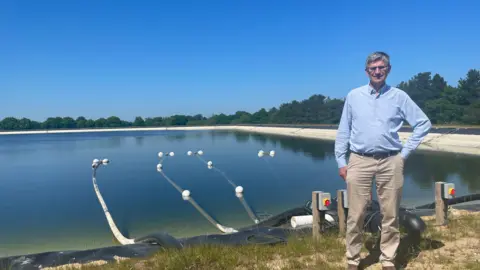 Malcolm Prior/BBC
Malcolm Prior/BBCMr Deane came together with five other farmers, including fruit growers, to build their own reservoir. It took four years and cost more than £1m.
It has proved vital, they say, with 15% of the stored water already used this year in the dry conditions.
But the group said obtaining planning permission was costly and difficult.
A government spokesman said it was working with the agricultural sector to improve its water supply resilience and establish more groups of farmers who could work together to develop their own reservoirs.
He added: "Over £104bn of private sector investment has been secured to fund essential infrastructure, including nine new reservoirs, to help secure our future water supply for farmers."
Are the dry conditions linked to climate change?
The prolonged dry weather is linked to what are called "blocking highs" when a high pressure weather system becomes stuck.
Scientists do not know if this blocked pattern is linked to climate change.
Global warming is expected to cause more extreme weather events globally.
Studies about our future climate suggest more and longer periods of dry weather as well as periods of less rainfall in the UK. Winters are likely to be wetter and warmer.
That could exacerbate other forms of drought like hydrological or agricultural drought, according to the Met Office.
Graphic by Erwan Rivault
